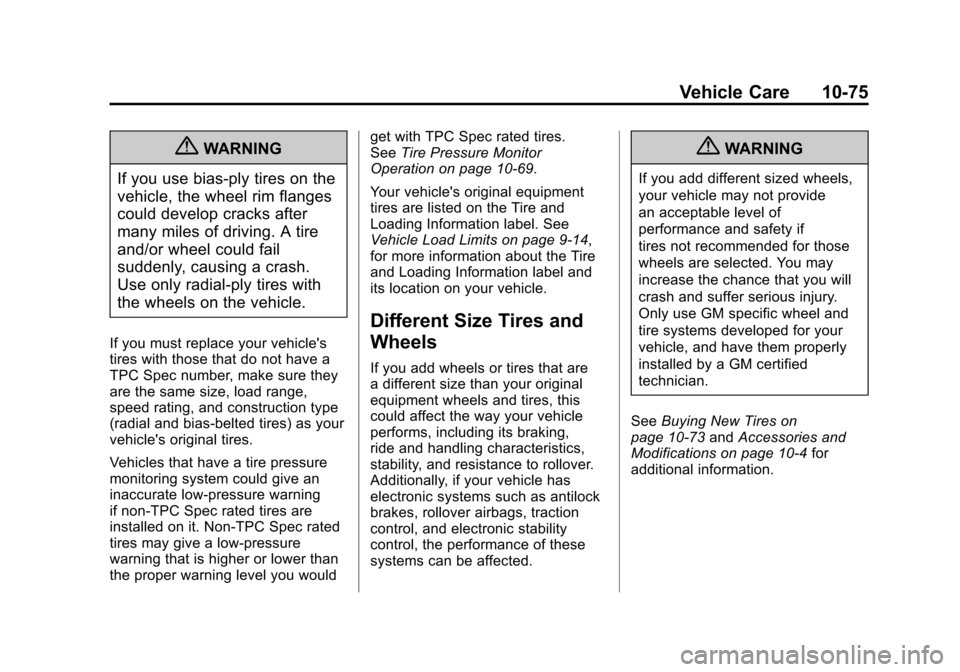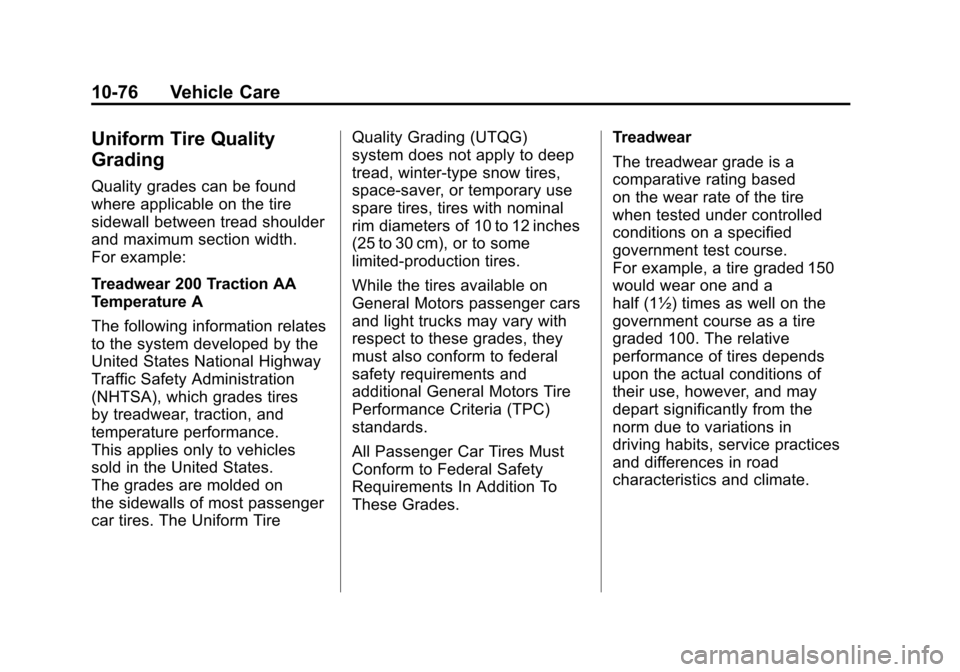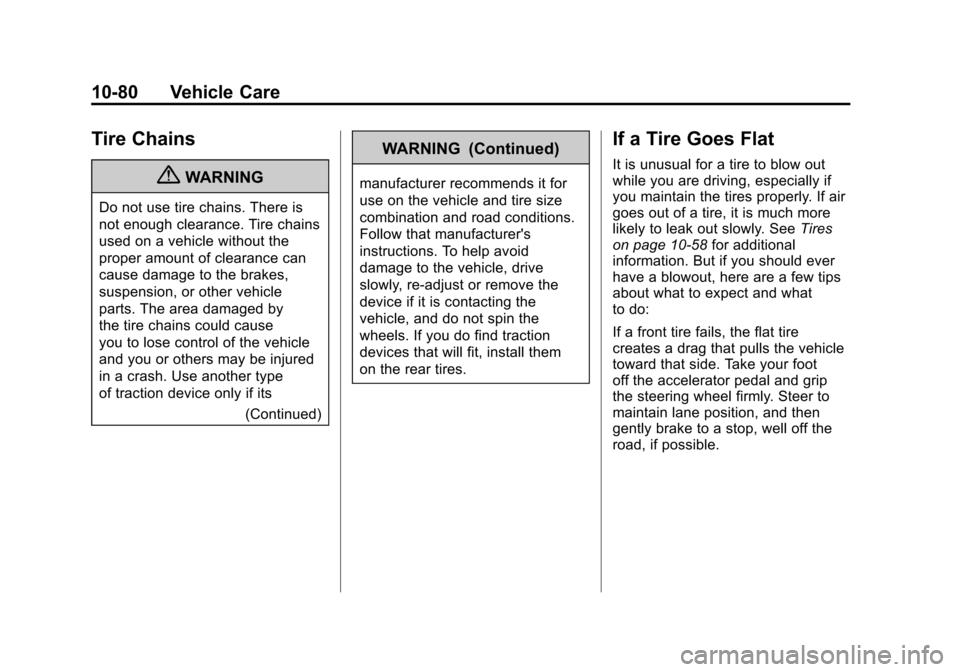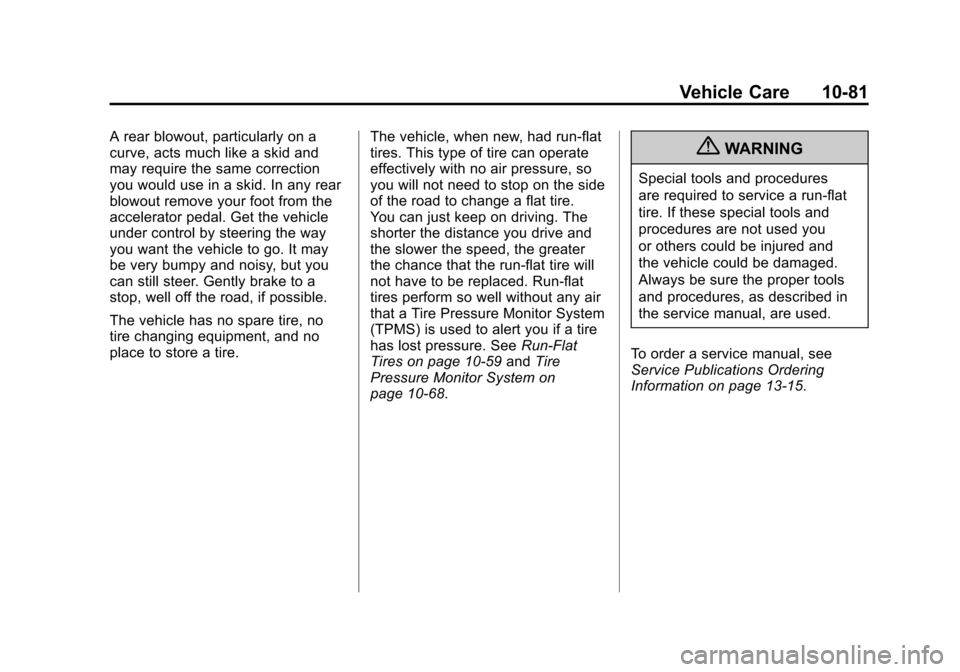Page 359 of 428

Black plate (75,1)Chevrolet Corvette Owner Manual - 2011
Vehicle Care 10-75
{WARNING
If you use bias-ply tires on the
vehicle, the wheel rim flanges
could develop cracks after
many miles of driving. A tire
and/or wheel could fail
suddenly, causing a crash.
Use only radial-ply tires with
the wheels on the vehicle.
If you must replace your vehicle's
tires with those that do not have a
TPC Spec number, make sure they
are the same size, load range,
speed rating, and construction type
(radial and bias‐belted tires) as your
vehicle's original tires.
Vehicles that have a tire pressure
monitoring system could give an
inaccurate low‐pressure warning
if non‐TPC Spec rated tires are
installed on it. Non‐TPC Spec rated
tires may give a low‐pressure
warning that is higher or lower than
the proper warning level you would get with TPC Spec rated tires.
See
Tire Pressure Monitor
Operation on page 10‑69.
Your vehicle's original equipment
tires are listed on the Tire and
Loading Information label. See
Vehicle Load Limits on page 9‑14,
for more information about the Tire
and Loading Information label and
its location on your vehicle.
Different Size Tires and
Wheels
If you add wheels or tires that are
a different size than your original
equipment wheels and tires, this
could affect the way your vehicle
performs, including its braking,
ride and handling characteristics,
stability, and resistance to rollover.
Additionally, if your vehicle has
electronic systems such as antilock
brakes, rollover airbags, traction
control, and electronic stability
control, the performance of these
systems can be affected.
{WARNING
If you add different sized wheels,
your vehicle may not provide
an acceptable level of
performance and safety if
tires not recommended for those
wheels are selected. You may
increase the chance that you will
crash and suffer serious injury.
Only use GM specific wheel and
tire systems developed for your
vehicle, and have them properly
installed by a GM certified
technician.
See Buying New Tires on
page 10‑73 andAccessories and
Modifications on page 10‑4 for
additional information.
Page 360 of 428

Black plate (76,1)Chevrolet Corvette Owner Manual - 2011
10-76 Vehicle Care
Uniform Tire Quality
Grading
Quality grades can be found
where applicable on the tire
sidewall between tread shoulder
and maximum section width.
For example:
Treadwear 200 Traction AA
Temperature A
The following information relates
to the system developed by the
United States National Highway
Traffic Safety Administration
(NHTSA), which grades tires
by treadwear, traction, and
temperature performance.
This applies only to vehicles
sold in the United States.
The grades are molded on
the sidewalls of most passenger
car tires. The Uniform TireQuality Grading (UTQG)
system does not apply to deep
tread, winter-type snow tires,
space-saver, or temporary use
spare tires, tires with nominal
rim diameters of 10 to 12 inches
(25 to 30 cm), or to some
limited-production tires.
While the tires available on
General Motors passenger cars
and light trucks may vary with
respect to these grades, they
must also conform to federal
safety requirements and
additional General Motors Tire
Performance Criteria (TPC)
standards.
All Passenger Car Tires Must
Conform to Federal Safety
Requirements In Addition To
These Grades.
Treadwear
The treadwear grade is a
comparative rating based
on the wear rate of the tire
when tested under controlled
conditions on a specified
government test course.
For example, a tire graded 150
would wear one and a
half (1½) times as well on the
government course as a tire
graded 100. The relative
performance of tires depends
upon the actual conditions of
their use, however, and may
depart significantly from the
norm due to variations in
driving habits, service practices
and differences in road
characteristics and climate.
Page 364 of 428

Black plate (80,1)Chevrolet Corvette Owner Manual - 2011
10-80 Vehicle Care
Tire Chains
{WARNING
Do not use tire chains. There is
not enough clearance. Tire chains
used on a vehicle without the
proper amount of clearance can
cause damage to the brakes,
suspension, or other vehicle
parts. The area damaged by
the tire chains could cause
you to lose control of the vehicle
and you or others may be injured
in a crash. Use another type
of traction device only if its(Continued)
WARNING (Continued)
manufacturer recommends it for
use on the vehicle and tire size
combination and road conditions.
Follow that manufacturer's
instructions. To help avoid
damage to the vehicle, drive
slowly, re‐adjust or remove the
device if it is contacting the
vehicle, and do not spin the
wheels. If you do find traction
devices that will fit, install them
on the rear tires.
If a Tire Goes Flat
It is unusual for a tire to blow out
while you are driving, especially if
you maintain the tires properly. If air
goes out of a tire, it is much more
likely to leak out slowly. See Tires
on page 10‑58 for additional
information. But if you should ever
have a blowout, here are a few tips
about what to expect and what
to do:
If a front tire fails, the flat tire
creates a drag that pulls the vehicle
toward that side. Take your foot
off the accelerator pedal and grip
the steering wheel firmly. Steer to
maintain lane position, and then
gently brake to a stop, well off the
road, if possible.
Page 365 of 428

Black plate (81,1)Chevrolet Corvette Owner Manual - 2011
Vehicle Care 10-81
A rear blowout, particularly on a
curve, acts much like a skid and
may require the same correction
you would use in a skid. In any rear
blowout remove your foot from the
accelerator pedal. Get the vehicle
under control by steering the way
you want the vehicle to go. It may
be very bumpy and noisy, but you
can still steer. Gently brake to a
stop, well off the road, if possible.
The vehicle has no spare tire, no
tire changing equipment, and no
place to store a tire.The vehicle, when new, had run-flat
tires. This type of tire can operate
effectively with no air pressure, so
you will not need to stop on the side
of the road to change a flat tire.
You can just keep on driving. The
shorter the distance you drive and
the slower the speed, the greater
the chance that the run-flat tire will
not have to be replaced. Run-flat
tires perform so well without any air
that a Tire Pressure Monitor System
(TPMS) is used to alert you if a tire
has lost pressure. See
Run-Flat
Tires on page 10‑59 andTire
Pressure Monitor System on
page 10‑68.{WARNING
Special tools and procedures
are required to service a run-flat
tire. If these special tools and
procedures are not used you
or others could be injured and
the vehicle could be damaged.
Always be sure the proper tools
and procedures, as described in
the service manual, are used.
To order a service manual, see
Service Publications Ordering
Information on page 13‑15.